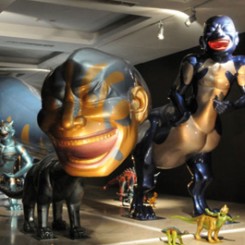Again and again we see it, one painting after another, including many imitations of famous Western masterpieces, such as Manet’s “Le déjeuner sur l’herbe” and “Execution of Maximilian.” It is particularly striking because the smile is worn not only by each of the executioners, officers and soldiers, but also by the victims. But this is not explained. It could just as easily be referring to the tension between Chinese tradition and ‘Western’ modernism as the political conflicts.
The more you look at these paintings and their smiles, the less certain they are. The laughter becomes a grimace, a rictus of pain, of embarrassment, of sheer effort, of insanity. But they also remind us of other smiles, such as the slowly shaking heads of sideshow clowns and the insincere smiles of shop assistants, showgirls, prostitutes and advertising – the fake smiles that can be bought and put on. The smile is one of the simplest of human gestures but it gives nothing away. The smile that does not go away is embarrassing, disquieting, eventually distasteful and offensive. It does not represent eternal bliss but permanent compulsion. The smile is tyrannical.
Smiles can be manufactured in quantity and many people can smile many smiles. A smile can be fixed, aped, affected, though Yue’s paintings question whether mere smiles can manufacture genuine happiness. But with a different preposition, the whole world would smile at you. As you can see, the problem with smiles is that they can run away, escaping your grasp.
Arnheim had subtly pried it out of Diotima and now could not help smiling when he thought of it. Was it a wistful smile or a malicious one? (Musil, p. 589)
Part I – Collective Memory
Meanwhile, a Chinese and Western group exhibition at OV Gallery avoids aping Western artistic mores, instead acknowledging that history and memory are unstable mediums with shifting values.
Yue Minjun’s art has relied heavily upon a conceit of ambiguity: do his self-portraits smile or grimace? Again and again his super-plastic face appeared in re-workings of propaganda photos, posters, and Western painting, most notably in “Massacre of Chios,” 1994 (Delacroix, 1824), “Princess,” 1997 (detail of Velázquez’ “Las Meninas,” 1656), “Execution,” 1995 (Goya, “The Third of May,” 1808), and “Le déjeuner sur l’herbe,” 1995 (Manet, 1863). The conceit was successful, slick, digestible, and cool, until it embraced its own parody with giant colourful automotive enamel dinosaurs (“Colorful Running Dinosaurs, 2008”) marching through the Shanghai Art Museum during the 2008 Biennale. The dinos were fun but the parade could go no further; and anyway, the financial bubble had just burst.
Before considering what Yue did next, we should reflect on why he became famous. It is trite to dismiss him as a Chinese contemporary artist who was picked up in China’s recent rise in the world art market – like a bird caught in a thermal that swirls up into the atmosphere until the cold and oxygen deprivation return it earthward. Such cynical jabs are almost as superficial as the unvarnished love for his paintings expressed by certain art world Barnums. The truth however is that, at his best, Yue produced works of extraordinary force and subtlety. Take for example “Princess” (1997), which was exhibited in “Thirty Years of Chinese Contemporary Art” at the Minsheng Art Museum in Shanghai this year. Velázquez’ Infanta has grown infantile. She is quite simply huge. She crowds the pictorial plane to the exclusion of everything else. The opulent room, the umpteen courtiers, and the painter himself, Velazquez, and also the King and Queen, reflected in the mirror above her head, have all vanished. And the princess, so delicate, so anonymous really, dressed in fine silks and taffeta, has been replaced by steel fabric, making her literally impregnable.
